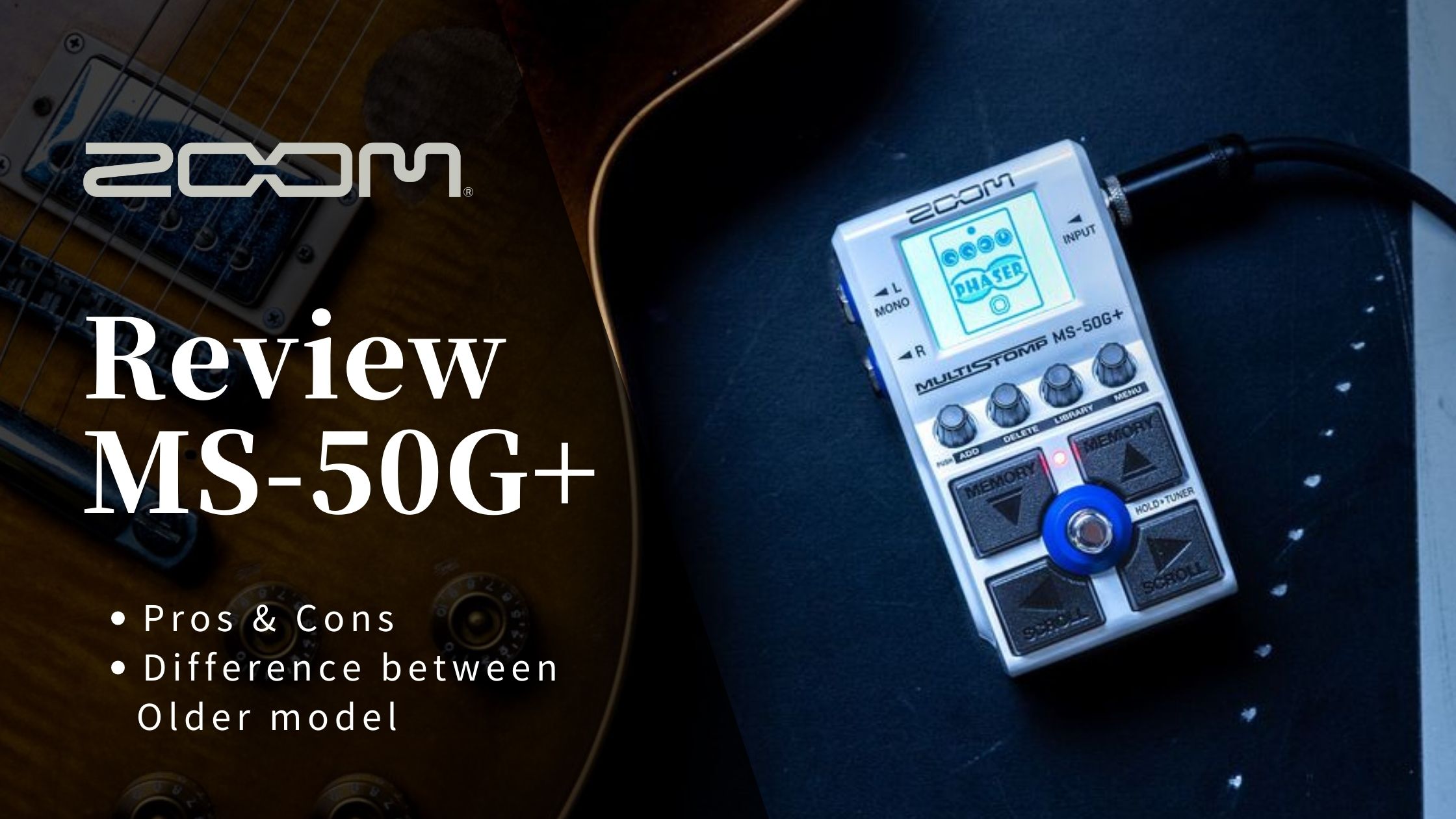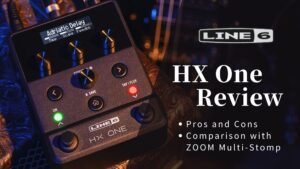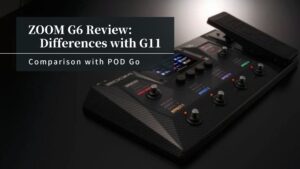Over 10 years since the release of the old model MS-50G, the MS-50G+ has finally been announced. With effects from two generations newer, the sound quality has significantly improved. Additionally, it adopts a cursor-type footswitch that allows for effect selection with your foot, addressing the operability issues of the old model. However, it does not include a MIDI terminal or true bypass, which were in demand. Nevertheless, with its price remaining mostly unchanged in the early $100 range, it can be considered a complete upgrade, making it a recommended replacement for users of the old model.
Are you dissatisfied with the sound quality of the MS-50G? Do you want to assemble a board with the smallest size possible? Or are you feeling overwhelmed by effects that you use only for a few seconds? If so, former music store employee Yosh (@Yosh_Guitar) thoroughly explains the advantages and disadvantages of the ZOOM MS-50G+, compares it with the old model MS-50G, and discusses who should and shouldn’t consider buying it.
Pros of the MS-50G+
The Smallest Multi-Effects Pedal Ideal for Board Integration
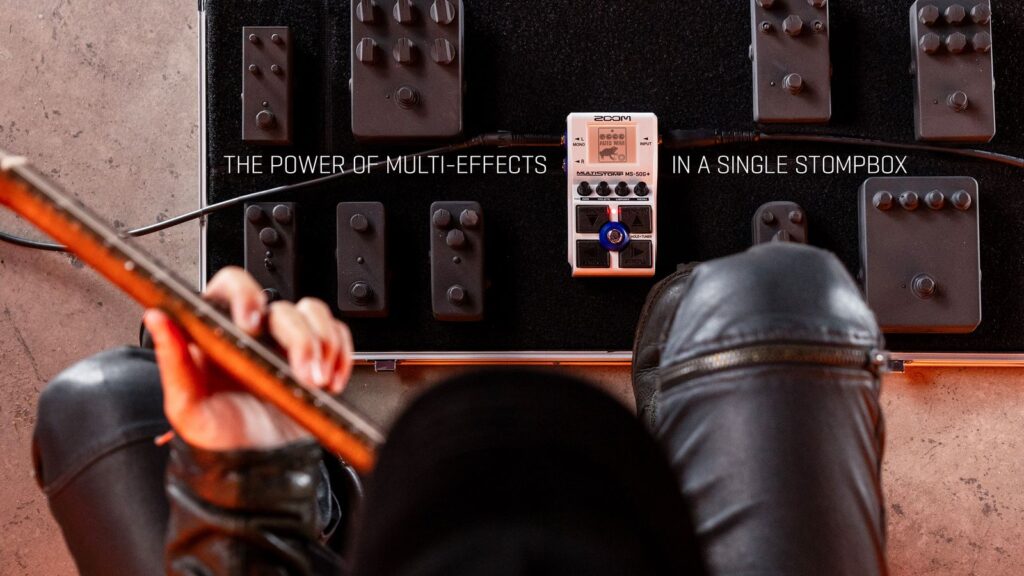
The MS-50G+ packs a variety of effects into a single pedal, including distortion, delay, reverb, and more. This is particularly beneficial for effects that are only used in specific songs or require extreme settings. It’s a great fit for guitarists with limited pedalboard space or those who prefer a simple setup.
Over 100 of ZOOM’s Latest Effects
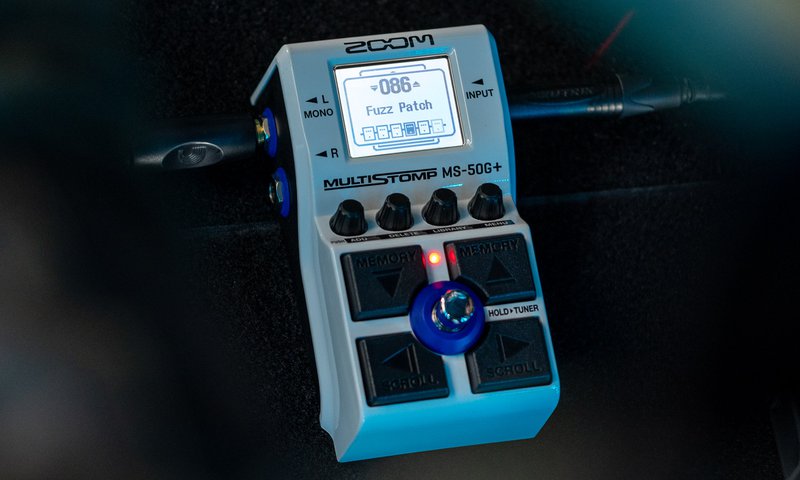
The pedal includes effects from ZOOM’s latest model, the G2 FOUR. It features a wide range of effects, from the latest original amp modeling to drive, modulation, delay, reverb, compression, filters, and SFX. It can create a broad spectrum of sounds, from high-end boutique pedals to unique ZOOM originals, and allows up to six effects to be used simultaneously. Users can also save their original sounds in up to 100 built-in patch memories.
Blending IR According to Picking Strength
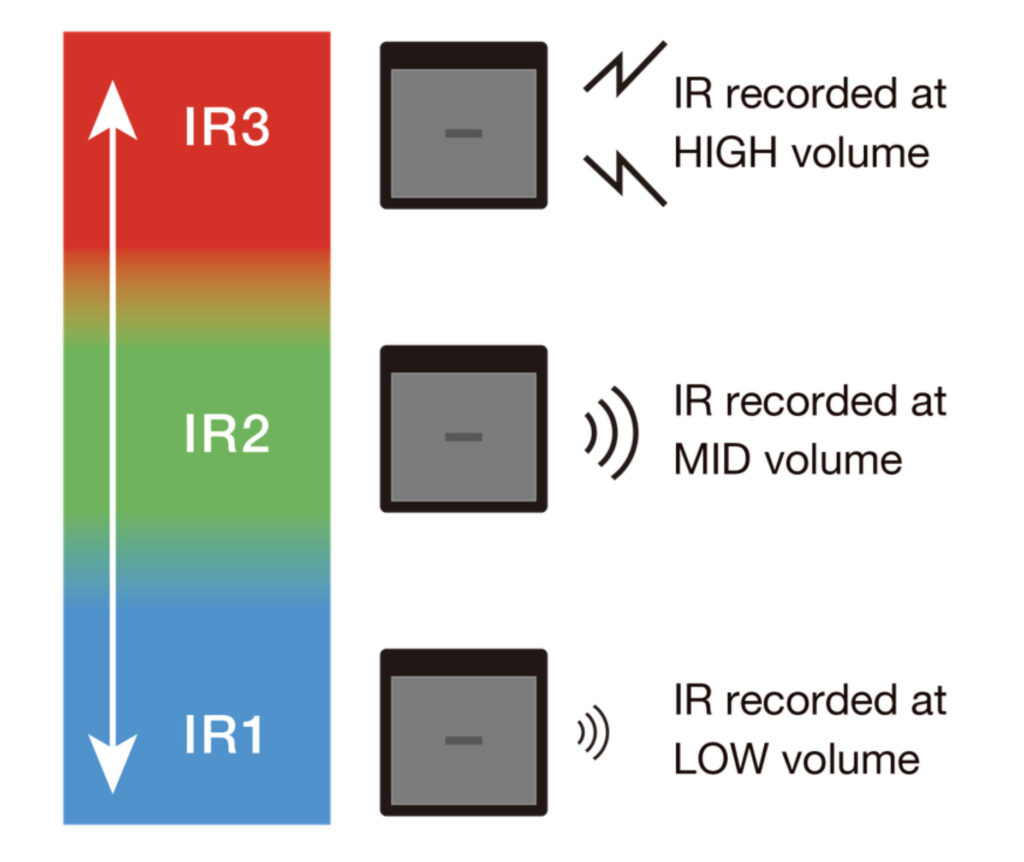
Adopting ZOOM’s newly developed “Multi-layer IR” feature. For a single IR, three different cabinet resonances (LOUD/MEDIUM/SOFT) are adopted depending on the volume. By blending these three types of IR according to the strength of picking and the volume of the guitar, it reproduces the sound reminiscent of a genuine guitar amp. It’s easy to hear even when playing with headphones and is ideal for line recording.
Color Backlit Display for Easy Stage Visibility
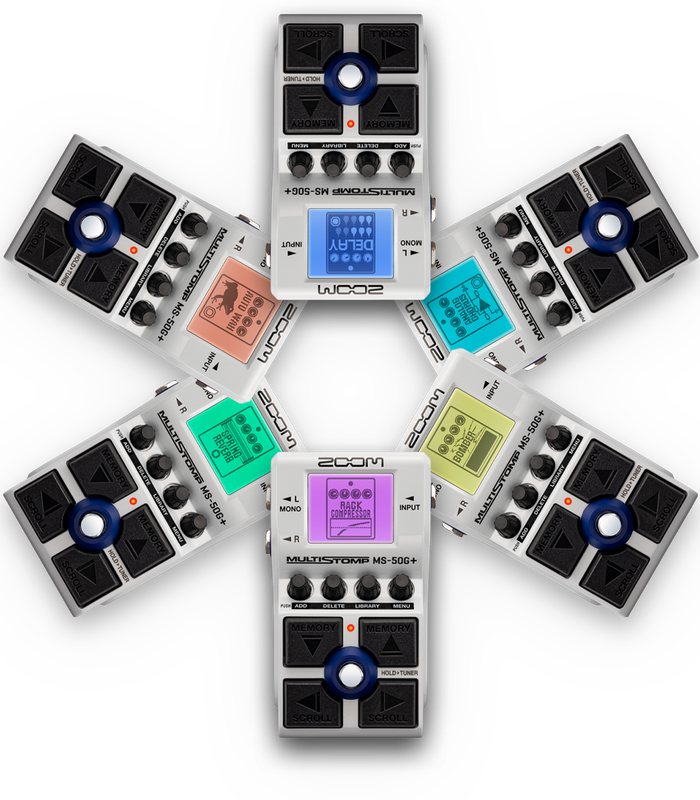
The pedal features a backlit LCD screen that changes color according to the type of effect selected, making it easy to identify the current effect type on stage. For example, drive is indicated by red, delay by blue, and filters by orange. This feature helps in smoothly switching effects during performances.
Footswitch Capable of TAP Tempo and Special Operations
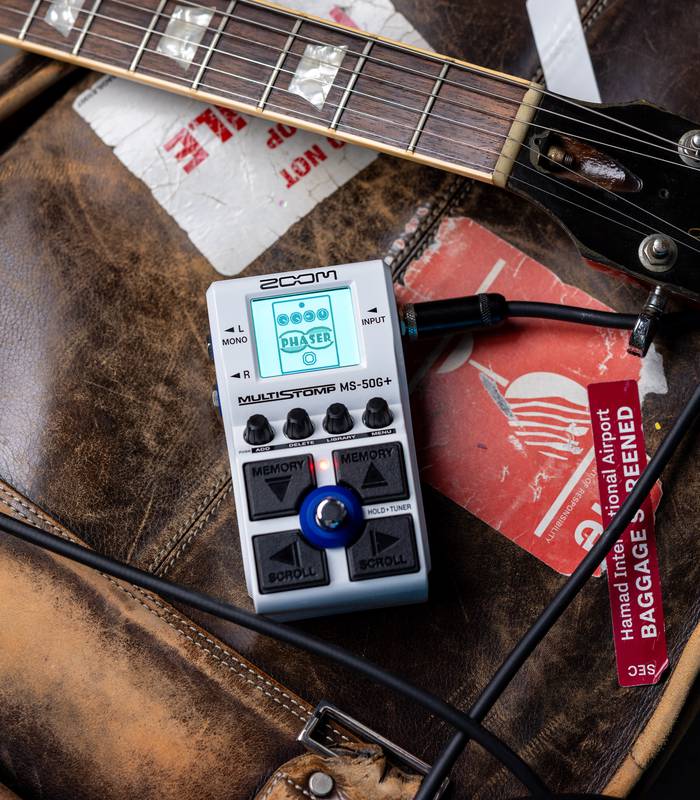
The footswitch is not just for toggling effects on and off; it can also be used for setting TAP tempo and performing specific operations for certain effects. This adds versatility to performances, allowing adjustments to tempo and effects without using hands.
Cursor-Type Footswitch for Operation with Feet
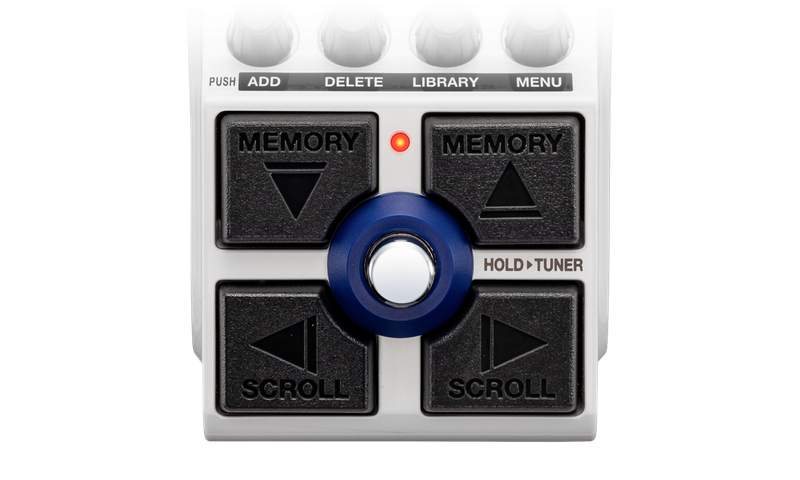
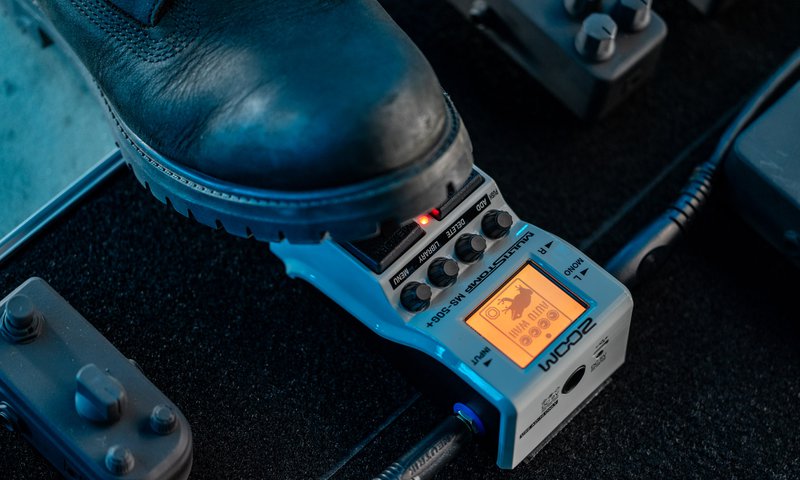
The pedal employs a cursor-type footswitch, enabling the selection of patch memories and effects with foot operations. This feature allows for changing effects and memories during a performance without needing to crouch down, potentially making the MS-50G+ the only necessary pedal for some players.
Good Operability with Switches and Knobs
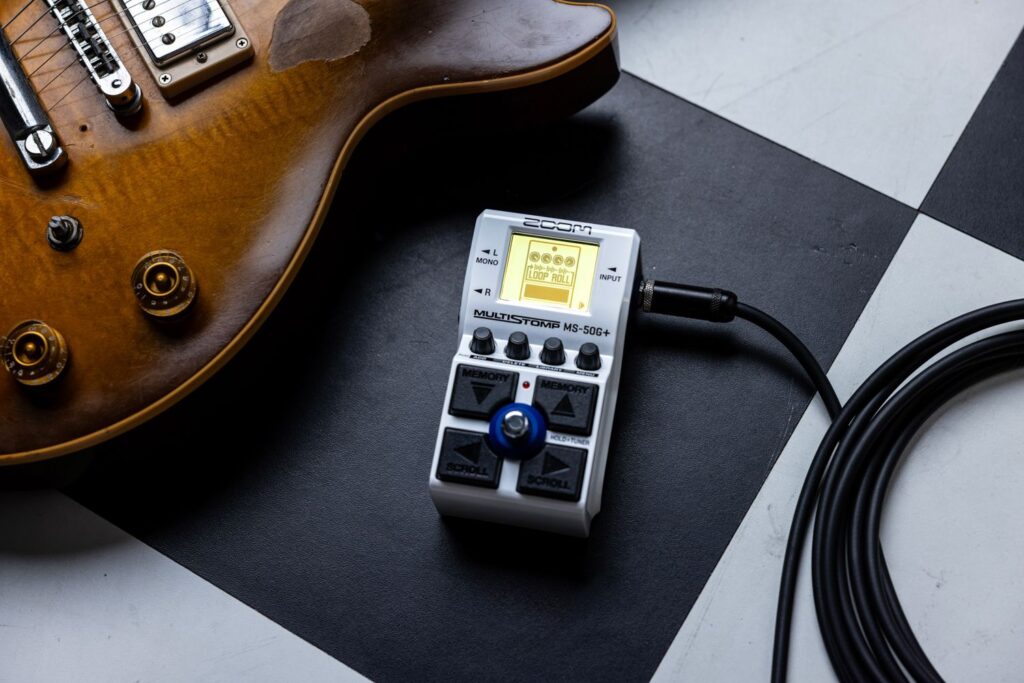
The pedal is equipped with four encoder knobs for intuitive tone adjustments. Those familiar with multi-effects pedals can operate it almost without a manual, offering a similar experience to using conventional stompboxes.
Further Intuitive Operation with iOS App Compatibility
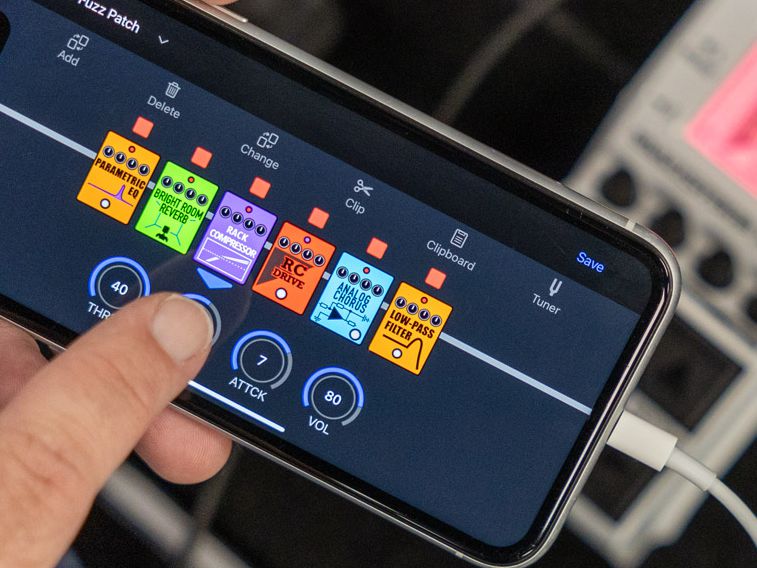
The MS-50G+ supports the dedicated iOS app ‘Handy Guitar Lab for MS-50G+’, which allows for adding effects, obtaining preset patches, and editing patch memories. The pedal connects to a smart device via a USB cable.
Powered by Power Supply, Batteries, or Mobile Battery

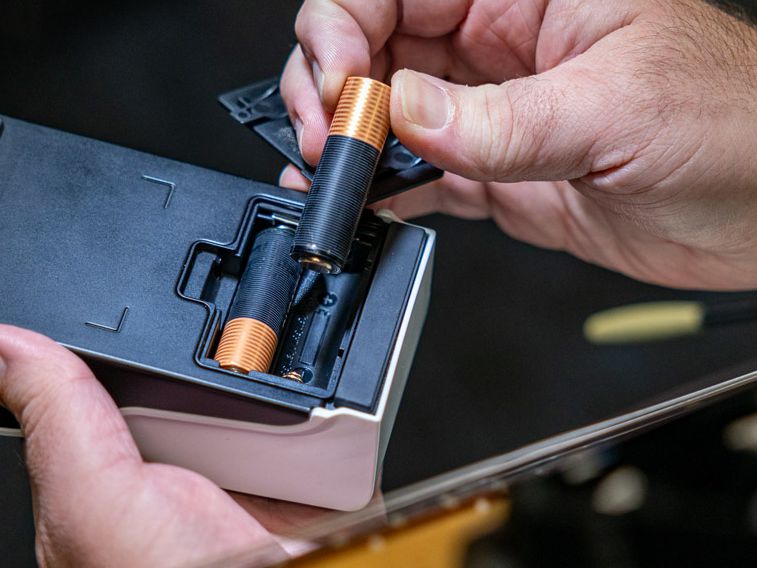
The pedal can be powered in three ways: two AA alkaline batteries for up to seven hours of continuous operation, an optional AC adapter (AD-16), or a commercially available USB mobile battery. This flexibility makes it suitable for various environments and situations.
Cons of the MS-50G+
Buffered Bypass Only
The MS-50G+ only offers a buffered bypass when the effect is off. While buffered bypass has the advantage of preventing tone loss with long cables, it would have been ideal to have the option to switch to true bypass, especially since effects like reverb are often connected at the end of the signal chain. If the change in sound quality is not a concern, then it’s fine, but for those who are particular, incorporating a line selector or switcher might be necessary.
No MIDI Terminal

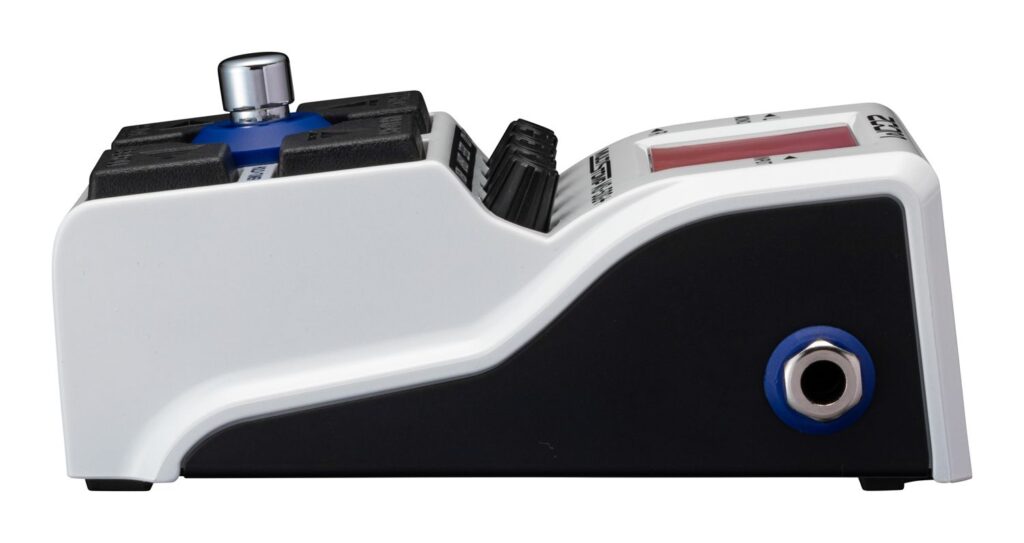
The MS-50G+ does not come equipped with a MIDI terminal. This means it’s not possible to switch effects using an external MIDI control switcher. This is likely a compromise due to size and cost considerations.
Cursor-Type Footswitch Can Be Difficult to Press
The cursor-type footswitch might feel a bit challenging to operate with the foot, especially during quick, on-stage performances where there’s a risk of misoperation. It’s important to get used to the position and feel of the footswitch during rehearsals.
Limited Simultaneous Use of Some Effects
While you can use up to six effects simultaneously, which generally feels sufficient, some high-quality amp modeling and certain spatial effects consume more processing power, reducing the number of effects that can be used at the same time. If you absolutely need to use multiple effects, some compromise on the effects might be necessary.
Effect List Overview
Dynamics (8 Types)
| Effect | Description |
|---|---|
| Compressor | MXR Dyna Comp modeling |
| Rack Compressor | Allows for detailed adjustments |
| Gray Compressor | ROSS Compressor modeling |
| Black Optical Compressor | Demeter COMP-1 Compulator modeling |
| 1176 Limiter | UREI 1176LN modeling |
| Zoom Noise Reduction | Noise reduction |
| Noise Gate | Noise gate |
| SlowATTCK | Creates a violin-like slow attack for each note |
Filter (7 Types)
| Effect | Description |
|---|---|
| Auto Wah | Wah effect based on picking strength |
| Low-Pass Filter | Low-pass filter effect is based on picking strength |
| Envelope Generator Filter | Filter controlled by footswitch operation |
| Sequence Filter | Z.Vex Seek Wah modeling |
| Step Filter | Changes the tone in a step-like fashion |
| Guitar Graphic EQ | 7-band mono EQ |
| Parametric EQ | Mono parametric EQ |
Drive (19 Types)
| Effect | Description |
|---|---|
| EP Drive | Maestro Echoplex preamp modeling |
| RC Drive | Xotic RC Booster modeling |
| TS Drive | Ibanez TS808 modeling |
| GoldDrive | Klon Centaur modeling |
| Sweet Drive | Mad Professor Sweet Honey Over Drive modeling |
| Zen O.DRV | Hermida Audio Zendrive modeling |
| Dynamic Drive | Tube-like drive |
| Plus Distortion | MXR Distortion+ modeling |
| Distortion One | BOSS DS-1 modeling |
| Squeak Distortion | ProCo RAT modeling |
| Red Crunch Drive | MI AUDIO Super Crunch Box modeling |
| Violet Distortion | Suhr Riot Reloaded modeling |
| TB Mk1.5 FUZZ | Tone Bender Mk1.5 modeling |
| Octave Fuzz | Fuzz with an upper octave |
| New York Muff Fuzz | Electro-Harmonix Big Muff Pi modeling |
| Wave Shaper Drive | Shapes the input sound wave, creating abundant harmonics |
| Razor Drive | Distortion occurs in different frequency bands |
| HG Throttle Drive | Mesa Boogie THROTTLE BOX modeling |
| Acoustic Simulator | Acoustic guitar simulator |
Amp Modeling (23 Types)
| Effect | Description |
|---|---|
| MS45OS DRIVE | Marshall JTM45 Offset |
| MS 1959 DRIVE | Marshall 1959 SUPER LEAD 100 |
| MS 800 DRIVE | Marshall JCM800 2203 |
| FD B-MAN DRIVE | Fender Bassman ’59 |
| FD TWIN-R DRIVE | Fender Twin Reverb ’65 |
| FD DELUXE-R DRIVE | Fender Deluxe Reverb ’65 |
| FD MASTER DRIVE | Fender Tone Master B Channel |
| UK 30A DRIVE | VOX AC30 |
| BG MK1 DRIVE | Mesa Boogie Mark I Combo |
| BG MK3 DRIVE | Mesa Boogie Mark III Combo |
| REVTI DUAL DRIVE | Mesa Boogie Dual Rectifier Orange Channel |
| XTASYBLUE DRIVE | Bogner Ecstasy Blue Channel |
| HW 100 DRIVE | Hiwatt Custom 100 |
| ORG120 DRIVE | Orange Graphic 120 |
| DZ DRIVE | Diezel Herbert Channel2 |
| MATCH30 DRIVE | Matchless DC-30 |
| KRAMPUS DRIVE | Combines a bright tone of 80s British amps with a tight low end of modern high-gain amps |
| REDLOOM DRIVE | Mixes the simple tone of early guitar amps with the rich harmonics of 60s tube amps |
| VELVET DRIVE | Balanced dynamics between clean and lead tones |
| MUDDY DRIVE | Reproduces the sound of vintage amps |
| 7 HEAVEN DRIVE | Extremely tight low end, suitable for 7 or 8-string guitars |
| POLLEX DRIVE | Suitable for heavily down-tuned guitars, ideal for Djent or heavy metal styles |
| BGNR UB METAL DRIVE | Bogner Uberschall modeling |
Modulation (22 Types)
| Effect Name | Description |
|---|---|
| CloneCho | Electro-Harmonix Small Clone Modeling |
| Chorus One | BOSS CH-1 Modeling |
| Tri Chorus | tc electronic Corona Tri-Chorus Modeling |
| Analog Chorus | Analog Chorus Style |
| Stereo Chorus | Stereo Chorus |
| Detune | Detune |
| Orange Tremolo | Tremolo |
| Phaser | Phaser |
| Stone Phaser | Electro-Harmonix Small Stone Modeling |
| Warp Phaser | One-Way Phaser Effect |
| The Vibe | Vibe Sound |
| Vintage Flanger | MXR M-117R Modeling |
| Kick FLNG | Footswitch-Controlled Flanger |
| Vibrato | Vibrato |
| Swell Vibrato | Vibrato with Post-Picking Effect |
| Octave | Octaver |
| Polyphonic Octaver | Polyphonic Octaver |
| Harmony Pitch Shifter | Pitch Shifter |
| Polyphonic Pitch Shifter | Polyphonic Pitch Shifter |
| Geminos Doubler | Doubling Effect |
| Ring Modulator | Ring Modulation |
| Slicer | Slicer |
Delay (15 Types)
| Effect Name | Description |
|---|---|
| Delay | Up to 4000ms long delay |
| Analog Delay | Analog-style delay |
| Tape Echo | Tape echo style |
| TapeEcho3 | Maestro Echoplex EP-3 modeling |
| Dual Delay | Two independent delays |
| Soft Echo | Soft-sounding echo |
| Slapback Delay | Slapback delay |
| Ping-Pong Delay | Delay sound alternates between left and right |
| Reverse Delay | Reverse delay |
| Modulation Delay | Delay sound with modulation |
| Filter Delay | Delay sound with filter |
| Pitch DLY | Delay sound with pitch shifter |
| HoldDLY | Hold delay using the control switch |
Reverb (9 Types)
| Effect Name | Description |
|---|---|
| Room Reverb | Room Reverb |
| Bright Room Reverb | Bright Room Reverb |
| Spring Reverb | Spring Reverb |
| Hall Reverb | Hall Reverb |
| Bright Hall Reverb | Bright Hall Reverb |
| Air Reverb | Air Reverb |
| Plate Reverb | Plate Reverb |
SFX (Special Effects) (6 Types)
| Effect Name | Description |
|---|---|
| BitCrush | Reduces the bit depth of the signal, creating a lo-fi, distorted sound. |
| Bomber | Produces a sound similar to a bomb dropping and exploding. |
| Mono Synth | A monophonic synthesizer effect. |
| Duo Phase | A phaser effect with two stages. |
| Ice Drive | A unique overdrive/distortion with a cold, sharp character. |
Comparison with the Older Model MS-50G
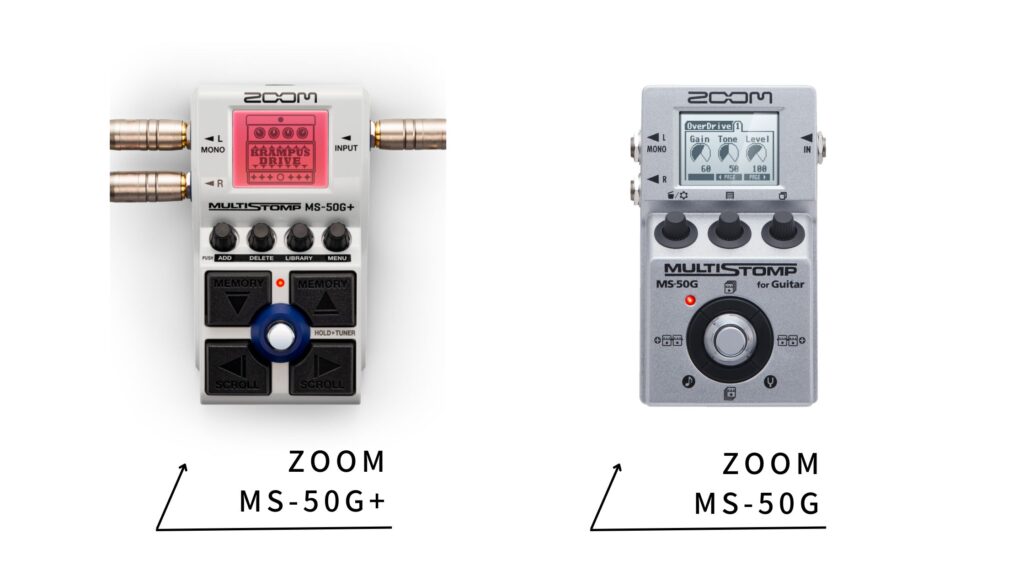
| Specification | MS-50G+ | MS-50G |
|---|---|---|
| Release Date | November 2023 | July 2012 |
| Market Price | $129.99 | $129.99 |
| Number of Effects | 100 | 100 + 72 (Addable via MS-50G Effect Manager) |
| Number of Simultaneous Effects | 6 | 6 |
| Footswitch | 1 + 4 Cursor | 1 |
| Sampling Frequency | 44.1kHz | 44.1kHz |
| A/D & D/A Conversion | 24-bit, 128x Oversampling | 24-bit, 128x Oversampling |
| Signal Processing | 32bit | 32bit |
| Frequency Response | 20 Hz – 20 kHz (±0.5 dB) (at 10 kΩ load) | 20Hz – 20kHz (±1dB – 3dB) (at 10kΩ load) |
| Display | Dot Matrix LCD (160 x 128 dot) | LCD |
| Input | Standard Phone | Standard Phone |
| Output | 2 x Standard Mono Phone Jack | 2 x Standard Mono Phone Jack |
| Patch Memory User Area | 100 | 80 |
| Master Volume | Yes | No |
| Battery | AA x 2, Continuous operation: 7 hours (with alkaline batteries) | AA x 2, Continuous operation: 7 hours (with alkaline batteries) |
| Power Supply | DC9V, 500mA | DC9V, 500mA |
| Dimensions | 2.4” x 3.11” x 5.23” (133 x 79 x 61 mm) | 2.3” x 3.05” x 5.13” (130.3 x 77.5 x 58.5 mm) |
| Weight | 0.77 lbs. (353g) | 0.77 lbs. (350g) |
Sound Quality
The MGS-50G is equipped with effects from the G3 generation released in 2011. Although the G5n was released in 2016, a multi-stomp model for this generation was not launched. The MS-50G+ features effects from the G11 generation released in 2020, representing two generations of evolution, significantly improving the sound quality. The frequency response of the MS-50G shows a maximum -3dB phenomenon, indicating that the sound pressure can halve in some cases. This suggests that the MG-50+ is superior in all effects.
Master Volume
The MS-50G+ has added a master volume control. This allows for a consistent overall volume level that does not change when switching patch memories, which is quite convenient when changing connected amps or effects.
Footswitch
The MS-50 did not allow for foot-operated patch switching. Consequently, there were even kits for pressing the scroll button with the foot for personal production. In response, the MS-50G+ adopted a cursor-type footswitch, evolving to enable effect and patch switching with the foot.
Worth Upgrading from the Old Model
The MS-50G+ has powered up in all aspects, including sound quality and operability. Especially with the significant improvement in sound quality and the price not being much different, it is worth upgrading for those who love the old MS-50G. Of course, for new purchases, the newer MS-50G is highly recommended.
Comparison with HX One
The comparison with Line 6’s HX One, released at the same time, is summarized in another article. In summary:
HX One:
- Line6 sound quality of the 200,000 yen class.
- Operated with a MIDI switcher.
- Uses external control.
- 268 rich effects.
- Looper function.
- Buffer/true bypass switch.
- No amp modeling.
- Only one simultaneous effect.
Therefore, if you are particular about sound quality, want MIDI switching, or desire true bypass, HX One is recommended. However, it is priced at $299.99, which is quite a difference compared to MS-50G+ ($129.99). The sound quality of ZOOM has also improved significantly, so unless you are extremely particular, the MS-50G+ might be a good choice.
Who Might Regret Buying the MS-50G+ and Who It’s Recommended For
The MS-50G+, released over a decade after the old model, is a long-awaited update. Despite its significant improvements in all aspects, its price remains pleasantly reasonable in the low $100 range.
The ZOOM MS-50G+ might not be the best choice for the following people:
- Those who frequently switch tones and find the footswitch insufficient.
- Those concerned about accidentally pressing the wrong button with the cursor-type switch.
- Those who want to use many effects, including amp modeling and spatial effects.
The weaknesses of the MS-50G+ lie in its foot operability and the limitation of using multiple effects simultaneously. If these are major concerns, it might be better to choose a larger multi-effects unit, such as the ZOOM G2 FOUR or higher.
The ZOOM MS-50G+ is recommended for:
- Those who have multiple pedals that are only used for specific parts of a song.
- Those who want to assemble as compact an effect board as possible.
- Those who find the limitation of not being able to use effects simultaneously on the HX One problematic.
- Those who do not need MIDI or external control.

